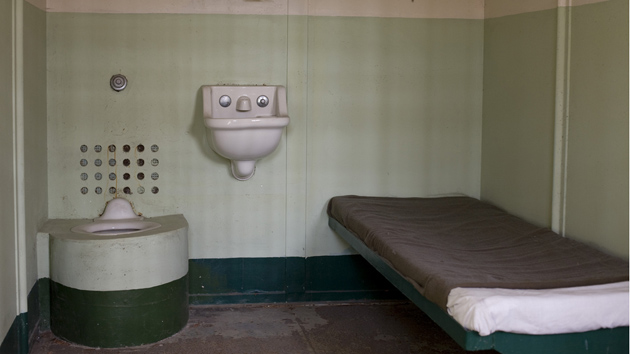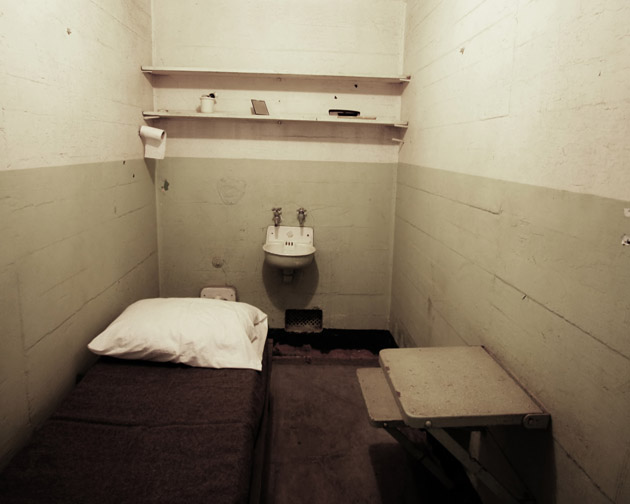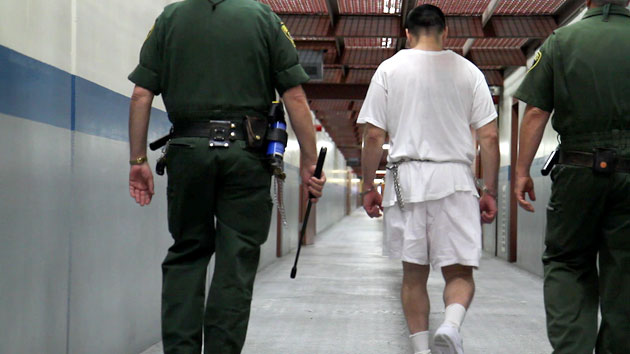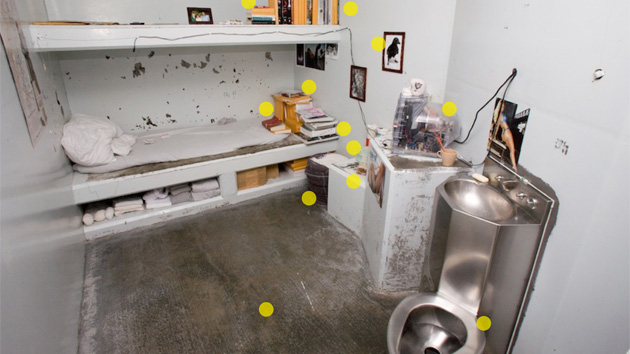
One night in March 2013, a 17-year-old named Kenny was walking with a friend through farm country in Reilly Township, Ohio. The boys had been drinking and were checking car doors in the hope of finding a little money when they came across a pickup with keys in the ignition. They decided to take it for a spin.
If you hadn’t guessed by now, Kenny wasn’t exactly thinking straight. He was just three weeks out of court-ordered rehab for marijuana possession and public intoxication, and his dad had just caught him stealing his anxiety medication. The pair drove a few miles to the home of Kenny’s girlfriend, whose mother saw the purloined truck and called the cops. The boys bolted, spent the night in a shed, and the next night were arrested while partying at a frat house. A judge found Kenny guilty of receiving stolen property worth less than $7,500, a low-level felony. He deemed Kenny, who had some pot on him when he was caught, a “delinquent child,” and sentenced him to six months at the juvenile correctional facility in Circleville.
But Kenny’s sentence wound up being rougher than the judge had perhaps intended. While the Circleville facility’s website boasts rehabilitative programs such as music, worship, woodworking, and education, he didn’t have much of a chance to take advantage of them. Shortly after arriving, Kenny landed in solitary confinement for fighting. Over the next six months he spent nearly 82 days in the hole—locked in his own room or an isolation cell—once for 19 days at a stretch, according to court documents.
I learned about Kenny’s case from legal filings in a lawsuit brought by the Obama administration against the state of Ohio. They make for some chilling reading. For years, the Department of Justice has pressured Ohio and other states to fix widespread problems in their juvenile prisons. In the fall of 2013, the department learned that some facilities were punishing kids like Kenny with long stretches of solitary. It investigated and filed suit the following March, asking a judge to immediately intervene because children would continue suffering “irreparable harm” if the practice wasn’t stopped. Kenny’s case was cited as a key example of the damage solitary could do.
While in isolation, Kenny—who was diagnosed with attention-deficit/hyperactivity disorder prior to the sixth grade—wrote to his mother, Melissa Bucher, begging her to make the two-hour drive to visit him. “I don’t feel like I’m going to make it anymore,” he wrote. “I’m in seclusion so I can’t call and I’m prolly going to be in here for a while. My mind is just getting to me in here.”
Bucher, a warm, lively woman who at first glance could be mistaken for Kenny’s big sister, insists that forced isolation turned her teen from a social kid with some mental-health issues into a depressed young man who shies away from others and experiences panic attacks at night. “Other inmates would call me a lot and tell me he was not doing good and hearing voices,” she said. When she visited Kenny, she noticed “he had scratch marks all over his arms. He was just digging into them.” Alphonse Gerhardstein, an attorney representing Kenny and others in a separate lawsuit that was eventually consolidated with the Justice Department’s case, noted in an email to the state attorney general’s office that the boy “bangs his head frequently” and “had fresh injuries.”
When I reached out to the Ohio Department of Youth Services last May to ask about Kenny’s situation—by then he’d turned 18 and had been moved to an adult prison—spokeswoman Frances Russ declined to comment on the particulars. But she wrote in an email that “seclusion is minimally used in our facilities to maintain safety and order” and insisted that kids in solitary get access to rehabilitative programs.
“They locked me in that little room with nothing,” Kenny countered when I reached him by phone a few weeks later. He was cold and lonely in the isolation room, Kenny told me, but that was nothing compared with the psychological torment. “I wasn’t even thinking straight, banging my head on the door and everything else. I was acting like a crazy person,” he said. “I had some of the roughest nights in there that I’ve ever had in my life.”
Desperate for human attention, he recalled busting the cell’s sprinklers and then spending nights soaked, on a wet mat. He lashed out too, and was rewarded with a separate conviction for harassing a staff member—Kenny told me he’d peed in a milk carton and threw it at a guard. “I’m not even like that, for real. I’m a good person. That place mentally messed me up,” he said. “I thought I was going to end up killing somebody or something.” Prior to being in solitary, he had never contemplated suicide, but in the hole, “I really wanted to die. I felt hopeless.”
The milk carton outburst resulted in additional time, which is why, at age 18, Kenny found himself in the adult lockup. It was “a traumatic and horrible experience for him,” Gerhardstein told me, and he ultimately spent another 50 days in nonpunitive seclusion, including time in the prison’s medical unit. He was “basically suicidal,” Bucher said. “He was a mess.”
The practice of isolating prisoners is deeply rooted in American history. In 1787, a group of prison reformers joined by Benjamin Franklin argued that if inmates were left alone in silence, they would become repentant. This Quaker-inspired method resulted in the creation, in 1790, of a penitentiary house containing 16 solitary cells in Philadelphia’s Walnut Street Jail. Some 50 years later, Charles Dickens visited the city’s lockups, of which he wrote, “The system here is rigid, strict, and hopeless solitary confinement. I believe it, in its effects, to be cruel and wrong.” In its most recent census of state and federal adult prisons, in 2005, the Bureau of Justice Statistics found that nearly 82,000 men and women were in “restricted housing”—a lowball figure that doesn’t include jails or immigration facilities.
The system for children evolved quite differently. Traditionally the core concept of juvenile justice has been parens patriae, literally “parent of the nation.” The state serves as a surrogate parent, educating and rehabilitating wayward kids. The excessive use of solitary in youth facilities was first documented in a handful of states in the 1970s and 1980s. But it really took off in the 1990s at the tail end of the crack epidemic, when conservatives began warning of “super-predators”—what the Princeton professor who coined the term described as “fatherless, Godless, and jobless” teenagers who would coldly victimize their communities. Voters panicked and states began passing laws that treated child perpetrators more like adults. By decade’s end, kids were routinely being put on lockdown for much of the day, and even held in cages on the yard, says psychiatrist Terry Kupers, an expert on solitary confinement who has testified in numerous lawsuits over jail and prison conditions.
As of 2011, the most recent year for which national data is available, the Department of Justice reported that 61,423 minors were being held in 2,047 juvenile facilities, of which roughly 1 in 5 used isolation—some prison officials prefer euphemistic terms like “reflection cottages” or “timeouts.” That didn’t even account for adult prisons and jails, which held roughly 95,000 more juveniles, according to an American Civil Liberties Union/Human Rights Watch estimate.
But even as prisons ramped up the use of isolation for infractions such as fighting, resisting a guard, or destruction of property, scientific evidence was piling up that demonstrated its devastating effects on the human brain. Back in the 1980s, Stuart Grassian, then a psychiatrist at Harvard Medical School, had interviewed adult prisoners in solitary in Walpole, Massachusetts, and found in them a distinctive set of psychiatric symptoms that resembled delirium. These included hallucinations, panic attacks, memory problems, obsessive thoughts, and impulse control. One prisoner described feeling “spaced out. Hear singing; people’s voices [saying], ‘Cut your wrists and go to Bridgewater and the Celtics are playing tonight.’ I doubt myself. Is it real?”
Up until around that time, brain researchers widely believed that we produce all the neurons we will ever have by early childhood. We now know, however, that new brain cells continue to develop in the hippocampus—a portion of the brain central to cognition and memory processing—throughout adulthood. When scientists began looking at animals kept in isolation, they discovered that they grew fewer new neurons than their nonisolated counterparts. That’s because isolation creates stress, and stress hormones inhibit neuron formation, which can result in harm to memory and learning. The effect is often more pronounced in juvenile animals, whose brains are undergoing rapid development. There “isn’t any question,” says Zachary Weil, an assistant professor of neuroscience at Ohio State University, that isolation is harmful to the brain and to overall health.
Last March, researchers from Brazil published a study in which they isolated adolescent marmosets, a kind of adorable South American monkey, in cages as small as two and a half feet across, and kept them from seeing or touching other monkeys. The animals soon grew anxious and spent less time on their usual grooming habits. Compared with controls, they exhibited “significantly” higher levels of the stress hormone cortisol and a steady drop in neuron production in the hippocampus—just one week in isolation decreased the observed number of new cells by more than one-third.
Ceylan Isgor, an associate biomedical science professor at Florida Atlantic University, has found that the effects of isolation on juvenile animals are “long-lasting.” As she explained it to me, the pruning of synapses—the connections between nerve cells—that occurs during adolescence and helps teenagers grow out of behaviors such as impulsiveness does not occur normally under conditions of extended isolation. Extrapolating from animal studies, she said, the results would suggest that kids already prone to breaking rules will become even more likely to act out: “You’re getting a whole different network.” And while the consequences may not be seen right away, they can pop up later as mental-illness symptoms or vulnerability to drug addiction. In other words, the way we often deal with messed-up kids in juvenile detention may increase the likelihood that they’ll reoffend down the road.
David Chura, whose 2010 book, I Don’t Wish Nobody to Have a Life Like Mine, chronicles the decade he spent teaching English to juveniles at the Westchester County Jail (an adult lockup in New York), has seen the effects of isolation firsthand. In 2004, the prison opened a new security housing unit, a.k.a. solitary wing. At first, it seemed like an improvement: The rooms, Chura recalled, were clean and quiet and “you could read or whatever.” But then his students began to deteriorate, rapidly and dramatically, and his teaching attempts fell apart: “The motivation for doing anything was lost.” Young men who used to fastidiously iron their orange uniforms stopped bathing. They became angrier and started acting out more. When they were allowed out of their cells into an adjacent recreation area—an empty room with a screen for fresh air—the kids would “plaster their faces against these screens and be yelling back and forth,” Chura told me, as though trying to prove, “I’m alive. I’m really still here.”
The class action suit in Ohio described a boy, “IJ,” who was 14 when he entered state custody in 2006. Grassian, by then retired from Harvard, was asked to review his records. When IJ first came into the system, Grassian testified, he was described as a “cooperative youth” who, despite his intellectual disabilities, didn’t require psychiatric drugs or mental-health services. But after a few years, and a lot of time spent in solitary, the teen was diagnosed with anti-social personality disorder and PTSD. Six years into his sentence, he was “seen as simply incorrigible…and a misogynist,” Grassian noted. He assaulted a staff member that year too. “I hated being in my room,” IJ testified. “It made me mad. It made my anger issues way worse.”
Then there’s the case of Jonathan McClard, who was 16 when he arranged to meet his ex’s new boyfriend at a car wash in Jackson, Missouri, one summer evening in 2007. According to the Southeast Missourian, he brought his father’s gun along and shot the other kid multiple times, leaving him severely wounded—surveillance footage captured Jonathan “calmly drinking a soda” afterward, the paper reported. When police arrived, he confessed, and was promptly hospitalized for suicidal ideation. He was “extremely happy,” he later told the paper, when he learned that his rival’s injuries were healing.
Jonathan was tried as an adult that November, sentenced to 30 years in prison, and placed in the juvenile wing of the Northeast Correctional Center in Bowling Green, where he began taking GED classes. In December, however, he landed in solitary after he “assumed an aggressive stance,” according to a Department of Corrections (DOC) representative, and “leaned forward” toward correctional officers who were counseling him on hygiene.
He was still in solitary when his mother, Tracy McClard, came to visit two weeks later, just days shy of his 17th birthday. The visit was “really hard,” she said. Jonathan told her he “wasn’t getting any human interaction at all,” was only allowed out of his cell every three days to shower, and was being fed through a slot in the door. (The DOC spokesman would only say that he had “daily interaction with staff.”) To keep himself occupied, Jonathan did mental math and read the Bible. “I could see a change in him,” McClard told me. “He looked so old.”
After he turned 17, Jonathan was transferred from solitary to a single cell in a correctional center near Bonne Terre en route to an adult prison. The next day, when McClard came home, her daughter said that someone from the prison had called several times but wouldn’t say what it was about. She called back. Jonathan was dead. He had hanged himself in his cell.
At the family’s request, Lindsay Hayes, who has worked as a suicide prevention consultant for the Justice Department, reviewed the boy’s prison records. The staff, he determined, knew of Jonathan’s history of suicidal thoughts and of his deep anxieties about his impending transfer, and yet he hadn’t seen a counselor for more than a week prior to the move. His handling by the prison authorities, Hayes concluded, “was the proximate cause of his preventable suicide.”
If solitary messes with your mind when you’re reasonably sane, it can also make existing psychiatric problems worse. And psychiatric problems are endemic among prisoners: The authors of a study published in 2008 in the Journal of the American Academy of Child looked at 16,750 incarcerated juveniles and found they had 10 times the rate of diagnosed mental illness as kids on the outside. Numerous state studies over the years have found that up to two-thirds of kids in lockup had diagnosable disorders. And when these kids act up behind bars, locking them in a room alone often exacerbates their condition. “There were times the sense was this kid was just being a pain in the ass, and they needed to be taught a lesson,” Chura recalled, when the real problem was that he had mental-health problems the staff wasn’t trained to deal with. According to a 2009 Justice Department report, of the 79 kids who had killed themselves at juvenile facilities over an earlier five-year period, 62 percent had spent time in seclusion, and more than half took their lives while they were in “room confinement.”
Juveniles placed in adult prisons are particularly at risk of landing in the hole—in part, ironically, because of laws designed to protect them. The Prison Rape Elimination Act, enacted to curb sexual abuse of prisoners, stipulates that unsupervised minors may not come into “sight, sound, or physical contact” with adult inmates. Because many prisons lack the space or the staff to separate teens from adults in a more humane way, psychiatrist Kupers told me, the kids “wind up in isolative confinement.”
The Justice Department recently intervened in a Michigan case on behalf of a group of boys in adult prisons, one of whom was raped and then allegedly spent more than five months in solitary by choice, petrified that he would be attacked again. While the lawsuit focuses on allegations that the prison didn’t properly separate juveniles from adults, the boys’ attorney, Deborah Labelle, says the isolation was clearly detrimental to the boys’ mental health: Four of her seven plaintiffs attempted suicide: two of them did so while they were in solitary, because “they just could not take it anymore.” (A Michigan corrections spokesman wouldn’t comment on the lawsuit.) “If a jail is that violent that they cannot ensure safety without locking people down,” one prison reform expert told me, “there are more problems than isolation.”

Lawyers with the Justice Department’s Civil Rights Division were arguing that solitary confinement is dangerous for children as far back as the George W. Bush era. From 2000 to 2005, attorney James Eichner worked in the division’s special litigation unit, which monitors violations of prisoners’ rights. During his time, Eichner told me, the division tried to convince states and counties that kids should not be treated just like “little adults,” because their “brains were wired differently.” But “that was not accepted as true the way it is now.”
The new science has finally started making its way into policy, however. In 2011, a United Nations torture expert said solitary should never be used on juveniles, and the American Academy of Child and Adolescent Psychiatry issued a similar decree the following year. This past July, Sens. Cory Booker (D-N.J.) and Rand Paul (R-Ky.) announced joint legislation that would prohibit the use of punitive solitary confinement on kids in federal detention facilities. “When you look at the evidence, you really see this is not a practice in keeping with the ideals of our country,” Booker told me. “It harms our young people. It harms them physically, it harms them emotionally.”
Under President Obama, the Civil Rights Division has put considerable energy into making the criminal-justice system less punitive and more rehabilitative. “Solitary confinement can be dangerous, and a serious impediment to the ability of juveniles to succeed once released,” then-Attorney General Eric Holder proclaimed in May, a week before the department announced a sweeping settlement in the Ohio case. Now, isolation can’t be used in the state’s juvenile facilities to punish youth with mental-health problems. (The ban will eventually extend to all of the kids.) If someone commits a violent act, he or she must be kept apart from others for two to four hours, but never more than a day.
The Justice Department has also gone after juvenile prison abuses in California, Indiana, Louisiana, Michigan, Mississippi, New York, and Tennessee. Staffers at a Mississippi youth facility operated by a private contractor, for example, found a young inmate hanging from a light fixture after he learned that his two-year-old had died in a car crash. He survived, but rather than being put on suicide watch, he was placed in isolation. Officials at Contra Costa County Juvenile Hall, in Northern California, put a 17-year-old with schizophrenia in solitary for 60 days for behavior that included “spitting, hearing voices, and talking to himself,” according to one complaint. And five correctional officers at New York City’s notorious Rikers Island Jail allegedly beat a mostly naked boy—including hitting him with a metal fan—for making a “smart remark.” After the hospital released the kid, he was allegedly punished with 75 days in the hole.
The movement to end juvenile solitary has gotten a boost from the Annie E. Casey Foundation, whose recommendations on juvenile justice reform have been adopted by more than 200 jurisdictions, including Baltimore, San Francisco, and Dallas County, Texas. This past summer, the foundation issued new voluntary guidelines calling for an end to “the use of room confinement for discipline, punishment, administrative convenience, retaliation, [or] staffing shortages.” In short: emergency use only. “No one says you can’t put a kid in a room if they’re temporarily out of control,” explains Paul DeMuro, a senior consultant to the foundation. “Say if you bring in 10 kids in a gang who are still fighting when there’s only three staff on duty from the midnight-to-seven shift. That qualifies as an emergency basis.” But only for an hour or two.
While most states have placed some limits (see map) on punitive solitary in their youth facilities (jails and adult prisons are another matter entirely), other states had to be dragged into it: In West Virginia, for example, a 2012 court order rescinded the ability of correctional staff to throw children in the hole for minor rule violations. Only truly out-of-control kids can be confined—but it can’t be a punishment, and there’s a 10-day maximum.
kids in the hole
Maximum length of punitive “room confinement” allowed in post-trial youth facilities

To be sure, some prison workers are worried about losing their disciplinary leverage. Elaine Harris, the spokeswoman for a union representing more than 1,300 West Virginia jail and prison employees, told me the court ruling was “certainly a contributing factor” in a riot last February at the state’s Lorrie Yeager Jr. Juvenile Center. Youth inmates, she added, have been using the court order to goad correctional staff: “You can’t do anything to me. I’ll have your job!”
But reformers point to Massachusetts as evidence that eliminating youth solitary can be a win for everyone. Since 2008, the state has had a policy of isolating only juveniles who are “exhibiting seriously disruptive or dangerous behavior” and can’t be calmed down in other ways, says Nancy Carter, director of residential operations of the state’s Department of Youth Services. Staff members have to get approval from a superior immediately upon putting a youth in isolation and must check on the kid every four minutes—kids on suicide watch cannot be isolated at all. “There was an adjustment period” after the rules were first introduced, Carter says, and a temporary uptick in assaults. Since then, however, there have been fewer assaults, and no more suicides.
Just this week, New York City’s Board of Correction voted to end solitary for inmates under 21 starting next January.
Ohio’s new rules, according to its youth services spokeswoman, already have reduced the total time spent in seclusion at the state’s youth facilities—which house about 440 kids total—from 667 days last January to just 35 in September. What’s more, violence by youth inmates hit a low that month of 118 incidents, a decline of 37 percent from January. “Ohio is doing much better,” says Gerhardstein, the lawyer who worked on Kenny’s case, which was settled along with the Justice Department’s. “They really are implementing the reforms.”
Kenny was finally released from prison on October 15, but he hasn’t been the same since he got out. He’s uncharacteristically restless, his grandmother, Linda Manzi, told me. He’s always pacing back and forth and “he gets panic attacks, he gets claustrophobic, like he’s pinned in.” When the family attended a fall festival, Kenny became so anxious standing in line for a hayride that he had to get away—he couldn’t deal with the crowd.
The latest from Bucher, Kenny’s mom, was that he was back in school full time, and seemed to be handling it. But the family still worries about him. When I asked her about Ohio’s reforms, Bucher said she felt mixed, because the changes had come too late to help her boy. “It really, really upsets me,” she said. “He still suffers and he never got help—no health, no nothing.” And even as the ink dried on the settlement, her son was still doing adult time in isolation: “What about Kenny?” she asked.















